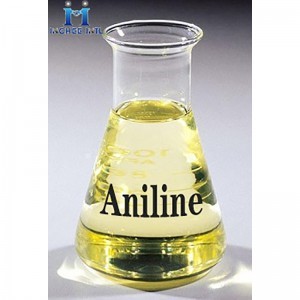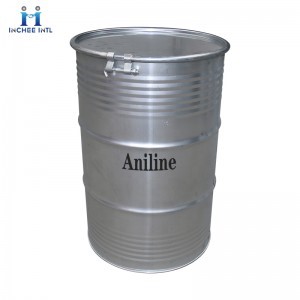Brief introduction:
Aniline, also known as aminobenzene, is an organic compound with the chemical formula C6H7N. It is a colorless oil liquid that starts to decompose when heated to 370℃. Although slightly soluble in water, aniline easily dissolves in ethanol, ether, and other organic solvents. This compound boasts a wide range of applications, making it one of the most important amines in various industries.
Physical and chemical properties:
Density: 1.022g/cm3
Melting point: -6.2℃
Boiling point: 184℃
Flash point: 76℃
Refractive index: 1.586 (20℃)
Appearance: Colorless to light yellow transparent liquid
Solubility: slightly soluble in water, soluble in ethanol, ether, benzene
Application:
One of the significant uses of aniline is in the manufacturing of dyes. Its ability to form colored compounds when combined with other chemicals makes it ideal for producing vibrant and long-lasting dyes. Aniline dyes are employed in various industries, including textiles, plastics, and leather goods. By using aniline-based dyes, manufacturers can achieve a diverse range of colors that are resistant to fading, ensuring products maintain their visual appeal over time.
Additionally, aniline plays a crucial role in the production of drugs and pharmaceuticals. As a versatile building block in organic chemistry, aniline serves as a starting material for the synthesis of numerous pharmaceuticals. Pharmaceutical companies rely on aniline derivatives to create drugs for various medical conditions. The ability to modify the structure of aniline allows researchers to develop medications with desired therapeutic effects.
Moreover, aniline finds application in the production of resins. Resins are essential in the manufacturing of plastics, adhesives, and coatings. By incorporating aniline into the resin formulation, manufacturers enhance the strength, durability, and flexibility of the final product. This enables the production of high-quality materials that can withstand demanding conditions and provide longevity.
Aniline’s versatility extends beyond dyes, drugs, and resins. It is also utilized as a rubber vulcanization accelerator. Rubber products, such as tires and conveyor belts, require vulcanization to enhance their strength and elasticity. Aniline assists in speeding up the vulcanization process, making rubber production more efficient. By incorporating aniline as an accelerator, manufacturers can reduce production time and improve the overall quality of rubber products.
In addition to its industrial applications, aniline can also be used as a black dye itself. This property makes it desirable in various artistic and creative fields. Artists and craftsmen can utilize aniline to create deep black hues that add contrast, depth, and richness to their creations. Its intense coloration and compatibility with different mediums allow for artistic expression and exploration.
Furthermore, aniline derivatives, such as methyl orange, find use as indicators in acid-base titrations. These indicators are crucial in determining the endpoint of a titration experiment, ensuring accurate measurements. Methyl orange, derived from aniline, changes color when the pH of a solution reaches a specific range. This allows scientists and chemists to precisely monitor and analyze the reactions taking place during titrations.
Product packaging: 200kg/drum
Operation precautions: closed operation, provide sufficient local exhaust air. Operation as mechanized and automated as possible. Operators must be specially trained and strictly abide by the operating procedures. It is recommended that the operator wear a filter gas mask (half mask), safety protective glasses, protective work clothes, and rubber oil-resistant gloves. Keep away from fire and heat. No smoking in the workplace. Use explosion-proof ventilation systems and equipment. Prevents steam from leaking into the workplace air. Avoid contact with oxidants and acids. When handling, light loading and unloading should be done to prevent damage to packaging and containers. Equipped with the corresponding variety and quantity of fire equipment and leakage emergency treatment equipment. Empty containers may have harmful residues.
Storage precautions: Store in a cool, ventilated warehouse. Keep away from fire and heat. The temperature of the reservoir shall not exceed 30℃, and the relative humidity shall not exceed 80%. Store away from light. The package should be sealed and not in contact with air. It should be stored separately from oxidants, acids and edible chemicals, and should not be mixed. Equipped with the corresponding variety and quantity of fire equipment. The storage area should be equipped with leak emergency treatment equipment and suitable containment materials.
In summary, aniline is a versatile organic compound with numerous applications in various industries. From dyes and drugs to rubber production and artistic endeavors, aniline’s importance cannot be undermined. Its ability to form colorful compounds, serve as a building block for pharmaceuticals, and act as a vulcanization accelerator make it a valuable substance. Additionally, its use as a black dye and an acid-base indicator highlights the diverse range of applications for aniline. As industries continue to innovate and develop, aniline will undoubtedly remain an essential component in their processes and products.
Post time: Aug-03-2023








